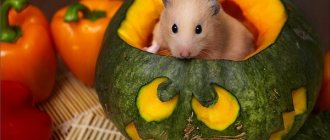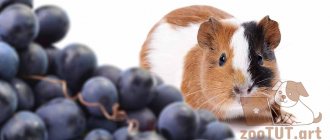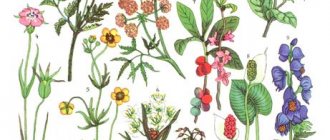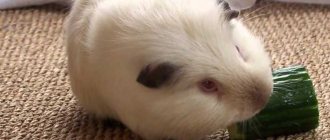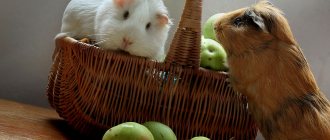A guinea pig's diet primarily consists of grass hay and high-quality guinea pig pellets or dried food. They also need a good supply of water and a selection of fruits and vegetables to ensure they have a healthy and balanced diet that meets their nutritional needs. Sometimes their owners like to treat them to foods intended for humans, such as bread. However, not all human food is safe for guinea pigs. So, can guinea pigs eat bread?
Green feed
In addition to hay, the animal loves to eat green food.
They minimize the risk of developing diseases of the digestive system and saturate the body with useful substances. Guinea pigs can eat celery, mint, spinach, basil, dill, parsley and arugula. They eat tansy, yarrow, chamomile, plantain leaves, clover, young sedge and dandelions with appetite. It is also recommended to introduce sprouted grains, cilantro, carrot tops, turnips and beets into the guinea pig's diet.
Not all greens are good for feeding your pets. They should not eat a lot of lettuce leaves. Some of them, in particular watercress, have a diuretic effect and irritate the respiratory tract.
Most wild plants are poisonous and unsuitable for animal feeding
Therefore, they must be collected extremely carefully. For safety reasons, guinea pigs should not be fed unknown plants.
For the same reason, animals are prohibited from eating greens purchased at the market.
If it has been treated with insecticides, it can cause severe poisoning and even death of the pet.
Physiological features of guinea pigs
No matter how “domesticated” animals are, the best way to preserve their health is to bring their living and nutritional conditions closer to those of their wild counterparts. Cereal plants can be cultivated or wild, each of them contains starch, but there are still differences in quantity. Therefore, in the natural environment such food is acceptable. Plus, wild animals move more and spend a lot of energy getting food, which means they require more energy.
Let's figure out why a large amount of carbohydrates is dangerous for these pets. Once in the body of pigs, starch is broken down into glucose, an easily digestible monosaccharide and source of energy. But such animals cannot absorb much of it, and the remainder, being in the digestive system, leads to fermentation. This creates favorable conditions for the development of harmful microflora, manifested by bloating and diarrhea.
Another feature is the need for a constant supply of food. If your pig is starving, stagnation may occur in the intestines. Therefore, there should always be food in the feeder (hay, grass, vegetables, fruits). But if it is a high-carbohydrate food, then the excess is deposited in the form of a layer and leads to obesity.
Paying attention to the physiology of these furry animals, we can conclude that it is possible to give guinea pigs bread, but not all types and in a certain quantity
What is allowed
Bakery products are included in the diet of animals, but not all of their types. Among the permitted baked goods are:
Black bread
It is baked using rye flour, which is healthier than wheat flour. Pigs happily eat pulp and crusts, but the owner must remember that even healthy bread is given in quantities of up to 30 grams per day. If the dose is exceeded, the pet will experience bloating and constipation.
Crackers
Dried slices of stale bread are excellent for sharpening the animal's teeth, but even this food is given in the amount of one small thin piece. In no case should crackers contain sugar, vanilla, cinnamon or other additives. To prepare crackers, take a stale loaf or rye pastry.
Bread
If these products include bran, sesame or flaxseeds, and do not contain salt, sugar and fat, then such a product will be useful for your pet, but only in moderation.
Even the permitted types of bread play the role of a delicacy, and not the basis of the menu.
What can you give hamsters from homemade food?
Hamsters can be given apples, but too much can cause stomach upset or diarrhea. Dwarf hamsters prone to diabetes should be fed apples sparingly and only as an occasional treat. Never feed your hamster apple seeds as they contain poison.
Hamsters love to save and store their food, so you can give your hamster a large piece of apple and see how much he eats and whether he saves it.
https://www.youtube.com/watch?v=h9OiWJAaZ2c
Although bread is a regular part of the human diet, it is important to know whether it can be given to pet hamsters. Important! Bread dipped in milk can be given to cubs that are not gaining weight well, aging individuals, hamsters that are recovering from an illness, as well as pregnant females. Important! Bread soaked in milk can be given to cubs that are not gaining weight well, aging individuals, hamsters that are recovering from illness, as well as pregnant females
Important! Bread soaked in milk can be given to cubs that are not gaining weight well, aging individuals, hamsters that are recovering from illness, as well as pregnant females
White
Since flour contains starch, which is a heavy carbohydrate, eating white bread by rodents can lead to bloating and fermentation in their stomach, as well as metabolic problems and permanent digestive disorders.
In addition, the appearance of such pathologies is inevitable:
- kidney necrosis;
- pancreas pathology;
- problems with the thyroid gland.
Another dangerous component of white bread is yeast, which leads to increased gas formation and even alcoholic intoxication as a result of its fermentation.
- flatulence;
- complete refusal of food;
- diarrhea;
- heart diseases;
- loss of orientation in space.
Bread is a source of large amounts of carbohydrates, its consumption will lead to obesity, to which hamsters are already prone. And as you know, excess weight negatively affects bones, joints and even the heart.
Did you know? The word "hamster" comes from the Avestan language and means "an enemy who throws to the ground." This name comes from the fact that these rodents bend the stems of plants to get to their seeds.
Black
The components that make up black bread are the following: rye flour, yeast and water. Despite the fact that such flour is beneficial for humans, it is harmful for hamsters. As already written above, starch is harmful to animals, but in black bread, even in small quantities, it is still present.
In addition to indigestion, frequent consumption of black bread can lead to stomach diseases such as:
- ulcer;
- gastritis;
- chronic colitis;
- heartburn.
Besides,
- problems with stool;
- bloating;
- changes in behavior.
The yeast contained in black bread leads to the appearance of a fermentation process in the intestines.
Dried (crackers)
All this does not apply to store-bought crackers, which contain flavorings and other substances harmful to the body that can harm the hamster, causing heart, kidney, intestinal and stomach diseases.
Important! To feed hamsters, you can only use dried, but not toasted, crackers. In the burnt crust, carcinogens are formed, which tend to accumulate in the body and release toxins that poison the animal
Bread
It is not recommended to add crispbread as an additive to a balanced diet for hamsters. Despite their low calorie content and completely dietary composition, they contain sugar and salt. As a result, the following problems may occur:
- diabetes;
- kidney and liver problems;
- stomach irritation;
- dry fibers can hurt your mouth.
From what people eat, fluffy can be fed porridge boiled in water without salt and sugar. Millet, buckwheat and other cereals are suitable. Rice is not recommended. You can give him low-fat cottage cheese and boiled eggs. Canned food – only baby vegetable purees without salt, sugar or preservatives.
Other products
Pigs eat almost everything
In general, these rodents can be called omnivores. But not all products are recommended for use by rodents.
Milk
Many people are interested in whether guinea pigs can have bread, and whether guinea pigs can have milk. Rodents in the wild do not eat these products, since it is not possible to obtain them. Accordingly, they are of no value to their body. Moreover, the rodent body is not able to break down lactose. Therefore, drinking milk can cause serious health problems. Milk can be given in small quantities only to young animals.
Bread
Bread, especially fresh bread, is also not recommended for furry pets. It causes bloating. We give crackers in small quantities. It is better to use black bread to make crackers.
Seeds and nuts
As for whether guinea pigs can eat nuts and a variety of seeds. There are no restrictions on these food products. But their consumption leads to obesity. Therefore, we include nuts and seeds in our diet in small quantities. Of the nuts, preference should be given to peanuts and walnuts. Almonds are not prohibited. As for seeds, you should give preference to pumpkin seeds. Or you can give a mixture of sunflower and pumpkin seeds. We first remove the husks from all the seeds.
Cereals
Of all the cereals that can be seen on store shelves, only oatmeal, ground into fine cereals, can be included in the diet of rodents. But you shouldn’t pamper your pets with them often. If oats are present in the diet, then this is quite enough. It is strictly forbidden to give boiled porridge to rodents. It will cause digestive problems. After all, in nature they eat only raw foods.
Rye croutons with garlic for soup or salad - cooking in the oven
Do you prepare salads with croutons? Do you eat soup with crispy croutons? Is it really necessary to use only store-bought croutons for this? Of course not. Let's prepare delicious crispy crouton cubes with garlic together for soups and salads.
By the way, you can make croutons from white bread using the same recipe, just reduce the baking time of the croutons in the oven, since wheat bread is more airy and dries out faster.
Let's prepare crackers with garlic, but keep in mind that by adding spices to them, we will get a separate snack.
You will need:
- black bread - 1 loaf,
- vegetable oil - 5 tablespoons,
- salt - 1 teaspoon,
- garlic - 4-5 cloves,
- spices to taste.
Preparation:
To make brown bread croutons fragrant, start by preparing aromatic garlic butter. To do this, pour the required amount of oil into a small cup (you can take sunflower or olive oil), squeeze the garlic into it. If you don’t have a special crusher, use a fine grater.
Stir the oil with garlic, add salt. You can add aromatic spices if desired.
Cut the bread into small cubes. Then place them in a large bowl or pan. Now, stirring constantly, gradually add the oil and garlic. Once everything is poured in, mix everything well so that every piece of bread is coated with butter.
Preheat the oven to 150 degrees. Place parchment paper on a baking sheet and place bread cubes on it. Place in the oven to dry. Stir the crackers from time to time and check readiness. Drying until golden brown and crisp may take 20 to 40 minutes. This will depend on the type of bread. Borodino will take longer to dry, but white will take 10 minutes.
Feel free to serve ready-made black bread croutons with hot soup, add to salad, or crunch like this, but with great pleasure.
100689 views
Feeding pregnant pigs and newborn piglets
Pregnant and lactating females need a complete and well-balanced menu. Their usual diet is supplemented with rosehip infusion, succulent food, vegetables and fruits. Pregnant females also need vitamins for their guinea piglets.
Although babies are born with teeth, at first they feed on their mother's milk. True, this does not prevent the cubs from eating “adult” food. Therefore, their cage should always have fortified food enriched with proteins.
Guinea pigs are herbivorous ornamental animals that eat mainly hay, vegetables, herbs and fruits. If they are fed correctly, they will greet their owners with joyful squeaks for many years.
How to pamper your hamster?
To pamper or reward your pet, you can treat your hamster with dried pieces of bread sprinkled with a drop of sunflower oil as a treat.
Crackers do not contain yeast, so they do not pose the same danger as fresh bread. Gradually introducing crackers into the diet will help grind teeth and make your pet happy.
Rusks should be dried, not toasted. Carcinogens in the charred crust can accumulate in the body and release toxins, poisoning the animal.
For variety, veterinarians recommend sometimes adding bread to a rodent’s diet, no more than 2 times a week, in a soaked form. But specialized food should remain the basis for a healthy lifestyle.
As a constant feed and to keep the body in good shape, it is necessary to give bread soaked in clean water:
- Aging individuals who have weak teeth and have lost the ability to process hard grains.
- Hamsters who have survived the disease and are undergoing adaptation.
- Pregnant and lactating females.
There is no doubt that the lifespan of a rodent is influenced by many factors, among which are proper nutrition and care for a living creature. The quality of food, consumption regimen and care form the basis for a prosperous life of a rodent.
Feeding regimen and technique
Healthy adult guinea pigs are fed twice a day, while pregnant guinea pigs and babies are fed up to four times a day. With two meals a day, rodents are offered succulent food for “breakfast,” and grain or a grain mixture and greens are prepared for “dinner.” In winter, greens are replaced (or supplemented) with hay.
It may be an unpleasant surprise for first-time owners to learn that pigs (even piglets!) eat their own feces. But this is how nature has established it: it is in this unusual way that colonies of beneficial bacteria enter the pig’s body. If you do not allow your pet and her cubs to eat your litter, this will immediately have a negative impact on the health of the animals.
The principles of proper feeding of guinea pigs are:
- Gradual change in diet. Violation of this principle can lead to disruption of the animal’s digestive system.
- Compliance with feeding hygiene rules. These rules include removing food residues, regularly washing the feeder and drinking bowl, and washing vegetables, fruits, and leaves.
- A hearty dinner is required.
- The presence in the diet of a sufficient amount of vitamin C, which the animal’s body cannot synthesize. A lack of this vitamin can cause paralysis in rodents! For an adult, the norm of vitamin C per day is 15 mg per 1 kg of body weight. When pregnancy occurs, this rate doubles.
Daily ration
Once the owner decides what to feed the guinea pig, he should pay attention to feeding standards. Here is an approximate daily diet for an adult from the pig family:
Here is an approximate daily diet for an adult from the pig family:
| Menu Component | Summer | Autumn | Winter | Spring |
| Fresh greens | 0.040 kg | 0.030 kg | ||
| Hay | 0.010 kg | 0.010 kg | ||
| Raw vegetables | 0.120 kg | 0.120 kg | 0.125 kg | 0.125 kg |
| White bread | 0.020 kg | 0.020 kg | 0.030 kg | 0.025 kg |
| Hard food | 0.040 kg | 0.040 kg | 0.040 kg | 0.040 kg |
Some veterinarians recommend feeding guinea pigs milk in the amount of 0.025 liters per day, regardless of season and age. Let us beg to differ with them. Rodents should not be accustomed to milk, because nature has not provided their body with enzymes that help digest dairy products.
You should be careful about your pet, because the given nutritional standards may vary depending on:
- degree of animal activity;
- health conditions;
- age.
So, pregnant females need more food. Therefore, the volume of food eaten for them increases by 30%.
Sorry, there are no surveys available at this time.
Why is a proper diet important?
Many foods that are familiar to humans are harmful to dogs. Some of them are even dangerous, due to the fact that nature has not created enzymes in their body to digest such food. Others are not suitable due to possible allergies and can lead to fatal consequences. Therefore, many owners can accidentally harm their dog because they do not know what dogs eat and what they don’t.
A dog can eat everything, but not everything is allowed to him
A proper diet includes a certain amount of protein, fat and carbohydrates. This ratio is different for each dog, as a rule, females need a little more fat, and dogs of muscular breeds need protein.
If a sufficient amount of protein is not supplied, the muscular system will be disrupted, since the muscles will not have anything to renew and build from.
If there are not enough carbohydrates in the diet, the pet will be lethargic, tired, and apathetic, since he has nowhere to get energy from. In addition, protein metabolism will also be disrupted, since due to a lack of carbon, the body will use its own body proteins for energy.
For your information! In the absence of fats, the condition of the coat and nails will be impaired, and females may have problems with fertilization and bearing offspring.
In addition to fats, proteins and carbohydrates, the animal’s body also needs vitamins and microelements. All these components help physiological processes proceed without deviation. Due to a lack of iron, the dog will develop anemia; due to a lack of vitamin A, problems with fur, claws, vision, etc. In general, the lack of vitamins and microelements in the diet has similar symptoms as with human abnormalities, which is why they are so important for both species.
Special ingredients and substances are important for dogs of decorative breeds (Chihuahua, Spaniel, Spitz, Pinscher, Yorkie, Dachshund); special dog food is sold for them.
A varied diet is the key to good health
What about banana peels?
Often, owners give a piece of this delicacy to their pets along with the peel. However, you shouldn't do this. Of course, banana is a plant food, but suppliers treat the fruit with wax, ethylene and chemicals so that the product retains its presentable appearance longer.
And during cultivation, various nitrates and pesticides are used to increase the rate of growth and ripening. All these Negative elements accumulate in large quantities in the peel. If they get into the animal’s stomach, then you will not be lucky enough to avoid disastrous consequences.
Therefore, it is important to remove the skin and soft tissues from the fruit before treating your pet with a healthy treat. It is also worth pre-processing an unpeeled banana: wash it thoroughly and scald it with boiling water.
Rules for feeding guinea pigs:
- It is recommended to feed at the same time, which the animals quickly get used to.
- There is no need to give too much food, and it is better to remove uneaten leftover food from the cage (except for hay).
- Green food, vegetables and fruits must be fresh.
- Hay and/or grass should be available to pigs at all times.
- Fruits and vegetables should be thoroughly washed, but not peeled. It is better to peel sweet peppers, as the skin is difficult to chew.
- Lettuce leaves absorb harmful substances, so it is recommended to rinse them thoroughly and dry them.
- The water in drinking bowls must be changed daily.
- From time to time you can give your pigs something to chew on.
Serving Size
There are three apple-related factors to consider when feeding your guinea pig apples:
- High sugar content;
- A large amount of vitamins;
- High concentration of acids.
It is better to cut the fruit. All these components, if contained in excess, can lead to digestive disorders, irritation of the mucous membranes and deterioration of the pet’s condition.
In this regard, you should feed your guinea pig fresh apples no more than three times a week. Moreover, it is worth giving it 2 - 3 slices, depending on the size of the fruit.
Dried fruits can be given in a bowl - every day in the morning, 3 - 4 slices.
But you cannot collect these seeds, store them separately for a long time and pour them out to your pet by the handful. The fact is that the skin of the seeds contains cyanic acid. Its concentration increases over time, making them poisonous. A large number of seeds, especially after long-term storage, lead to serious poisoning of the body and even the death of the pet.
Thus, a guinea pig can be fed fresh apples three times a week, and dried apples every day in the morning. Do not give soaked or compote-boiled apples. Apple seeds can only be given from fresh fruit in a few pieces; the seeds cannot be collected and stored separately, as extremely toxic cyanide acid accumulates in them.
Explanations for the table
The table itself is slightly lower.
The column “sometimes a little” means that you can feed guinea pigs these products only as a gift - give them once every two days, in portions of no more than 15 g (if a little more, then nothing, but don’t take them away). Everything should be clear with the “possible” and “not allowed” columns. Prohibited foods should not be fed, even experimentally, if you do not want to pamper your pet.
All products must be fresh (except hay, of course). If there are even slight doubts about the quality, it is better not to feed such food. Buy food from suppliers whose products you have confidence in. For example, the amount of pesticide an apple may contain is safe for humans, but will have serious consequences for small rodents.
Products must be environmentally friendly.
Can guinea pigs eat bread?
It is indispensable in our daily life. It comes in different types, black and white, with and without yeast, dry and stale, with and without additives. Recently, it has even been baked from artificial wheat. All this is of great importance.
Fresh bread is strictly contraindicated for guinea pigs. It should not be given, as it is poorly digested and remains to ferment in the stomach. White bread also often leads to bloating and worsens overall health.
In principle, if you feed your pig bread quite rarely and in small portions, then it is possible. But, if you do not need your pet to suffer from digestive problems and constipation, then it is better to abandon this idea.
Other bakery products
Experts do not recommend giving your pet buns, crackers, pasta, cookies, crackers, toast and much more that are tasty and nutritious for humans. In most cases, these products contain various additives, are subject to heat treatment and only cause harm to the rodent’s digestive system.
Crackers
There are exceptions. Crackers are one of the most harmless products listed above. Of course, if we are not talking about store-bought crackers with various spices and additives.
Crackers will not ferment in the stomach and will serve as a tasty treat for your pet. But only in small doses: no more than 30 grams.
Guinea pig nutrition: general rules and recommendations
Your pet's daily menu should be balanced and varied.
It is very important to choose fresh and natural foods for feeding, which contain large amounts of essential vitamins and substances beneficial to the animal’s body.
You can purchase food for your animal both in veterinary stores and in regular supermarkets, choosing vegetables, herbs and fruits grown without the use of large amounts of chemicals and pesticides. In the summer, you can collect succulent grass yourself in the forest, in places remote from roads.
Important. A guinea pig needs to be fed at least 2 times a day. If a pet remains hungry for 18 hours or more, its health can be greatly undermined, and even death is possible.
If a pet remains hungry for 18 hours or more, its health can be greatly undermined, and even death is possible.
Compliance
One of the main rules in feeding a pet, which should be strictly adhered to from the first days of the animal’s appearance in the house, is the prohibition of overfeeding.
Overfeeding leads to overweight and obesity, which, in turn, negatively affects the health of the animal's heart and liver.
Important. Clean water, as well as grass, hay or grain, must be present in the pet’s cage at all times.
Mode
It is recommended to give food to the animal at the same time, thus establishing a feeding schedule. Standard feeding is recommended in the morning, afternoon and evening.
Change of feed
A radical change in food is quite stressful for the animal, which can harm its health. If there is a need to change food, it is best to do this in stages, gradually adding some new food to the usual main product.
New products
When introducing new, unusual foods into the animal’s diet, you should very carefully monitor the pet’s condition. The first portions of new food should be minimal.
If the animal begins to have any reactions, including with stool, the new product must be completely excluded from the diet.
Guinea pigs should only be given fresh food.
Food quality
Much attention should be paid to the quality of the food served: fresh vegetables, herbs, fruits and berries must be ripe and juicy. Before giving such food to an animal, the product must be thoroughly washed with running water. If the animal is given ready-made food, it is necessary to check the expiration date and store it in accordance with the instructions on the packaging
If your pet is given prepared food, check the expiration date and store it according to the directions on the packaging.
Important. It is strictly forbidden to give rotten, spoiled or moldy food to your pet.
Availability of water
Despite the fact that the animal receives a large amount of moisture from juicy, ripe vegetables, a drinking bowl with clean water should always be available. In the summer, your pet may need more water than in the winter.
Important. Water for the animal should be bottled
Cleanliness of dishes
The pet's home, as well as its dishes, must always be kept clean.
The water in the drinking bowl should be changed regularly, and the drinking bowl itself should be cleaned using a special brush. The same applies to all bowls and plates with food, especially dishes on which fresh vegetable or fruit food is served.
Dishes must be washed thoroughly without using dishwashing liquids. If necessary, plates and bowls can be washed with water and regular baking soda.
The bowls themselves can be ceramic or plastic.
Green feed
Green food consists of lush field or meadow grass: sage, chamomile, burdock, plantain, clover, etc. This product is a particularly important element in the diet of a guinea pig, so it is necessary to provide the animal with fresh herbs all year round. Spinach leaves or dill stalks are perfect.
Hay and branches
Hay and branches are so-called roughage or dry food, which helps maintain your pet's digestion and also wear down teeth.
The hay must be fresh and clean, free from foreign impurities and dust. Twigs for guinea pigs can be taken from willow, birch, linden, rowan, alder, pear or apple.
Important. It is forbidden to give the animal citrus and coniferous branches, as well as branches from trees whose fruits have hard seeds: peach, apricot, cherry, sweet cherry, plum, etc. On average, pigs eat 2-3 times a day.
On average, pigs eat 2-3 times a day.
Read with this
Pet diet at home
The diet of guinea pigs should be varied, but without daily experiments, which can cause problems in the animal’s digestive system. Standard set of products:
- carrots (pumpkin, zucchini, beets),
- apple (hard pears, raspberries, apricots, peach);
- white or cauliflower;
- high-quality granulated food;
- greens (parsley, dill, clover, dandelion leaves, wood lice grass);
- unlimited quantities of hay.
In the summer season, carrot and beet tops, cucumbers from your garden and fresh grass are good complementary foods.
Vegetables
Vegetables that you can offer your pig and choose the types that she tolerates well:
- carrot;
- beet;
- zucchini;
- pumpkin;
- cauliflower;
- White cabbage;
- Bulgarian pepper;
- swede;
- turnip;
- green pea pods;
- cucumbers;
- tomatoes.
It is recommended to purchase home-grown vegetables grown without pesticides. They can be dried for the winter or frozen.
As for cabbage, the opinions of breeders are divided. Sometimes it is recommended to completely exclude this product from the pig’s diet so as not to provoke bloating. However, cabbage in very limited quantities is extremely useful for the animal, as it contains many substances that prevent obesity.
Fruits and berries
Fruits and berries of your pet's choice:
- apples;
- pears;
- peaches;
- apricots;
- plums;
- cherry;
- cherries;
- citrus;
- blackberry;
- raspberries;
- strawberry.
Each type of fruit and berry is offered to the pigs one at a time and their health is monitored. Some berries can cause an allergic reaction.
Fresh greens, grass and hay
You can safely give a wide variety of greens, provided that they are clean, fresh, and not treated with chemicals:
- dill/parsley;
- spinach, lettuce, celery;
- greens of sprouted wheat and oats;
- leaves of strawberries, raspberries, currants, gooseberries;
- carrot and beet tops;
- meadow grass.
Everything picked in the forest and in the countryside must be thoroughly washed. If the pig is kept in a house with a garden plot, it makes sense to designate a garden bed where you can plant herbs specifically for the rodent. At home it is easy to grow clover and alfalfa, parsley, dill, lettuce, and garden quinoa.
You cannot collect grass for hay along the trails. As weeds in gardens you can find chickweed, acorn grass, wheatgrass, purslane, plantain and even nettle. These herbs can be given to the pig during the season, drying under a canopy. Wheatgrass produces high-quality hay for the winter. If you prepare hay in sufficient quantities, feeding your pet in winter will not be a problem. Dry the grass in such a way that it is not exposed to sunlight for at least one and a half months. The best option at home is an electric dryer, which will help you easily and quickly prepare not only herbs, but also organic fruits, vegetables, and berries for feeding the animal in the winter. A rodent always needs hay, so you need to take care of preparing it in advance.
Vitamins and minerals
The fact is that the body of guinea pigs does not contain a special enzyme, I-gluconolactone oxidase, which is involved in the synthesis of vitamin C from glucose. It is because of this circumstance that your pet is not able to get this incredibly valuable vitamin from regular food. Your task throughout the animal’s life is to regularly provide it with ascorbic acid.
With a lack of vitamin C in the body of an adult, the following pathologies can occur (most often manifested as symptoms of scurvy):
- retardation of movements, visual lameness (although the animal did not fall), decreased activity;
- lack of appetite, external lethargy and indifference to what is happening;
- diarrhea, swelling of joints;
- there is blood under the skin and in the secretions;
- bleeding and falling out teeth;
- the animal looks disheveled, the fur is crumpled, and may even fall out.
In summer, the diet should be replenished with plenty of fresh greens, plants, leaves and stems, not to mention fresh vegetables and fruits. Most of these fruits contain ascorbic acid. As for the cold winter period, it is necessary to gradually add synthetic ascorbic acid to the diet. Pregnant females, older individuals and young animals need an increased dose of vitamins, as well as an increased amount of food.
For an adult, you need at least 15 mg of vitamin C per kilogram of weight daily; for pregnant women and young animals, approximately 40-45 mg per kilogram of weight should also be given every day.
The greatest amount of vitamin C is found in the following vegetables, plants and fruits: tomatoes, broccoli, apples, nettles, burdock, as well as raspberry and currant branches (always with leaves), dandelion, basil, mint, parsley, cabbage, kiwi. Remember that many of these plants should be given in strictly limited quantities.
Almost all of the listed vegetables and fruits can be found in the public domain in the summer and autumn, which is why preference should be given to these products in the summer rather than synthetic vitamins.
Be careful when choosing a place to collect all the necessary herbs (in case you do not trust herbs from pet stores). Try to choose areas far from factories, roads and industrial enterprises to collect them. The greatest danger is in grass collected from parks and city lawns. Typically, such plants are treated with harmful chemicals against parasites, which will also negatively affect your pet.
There are only two problems with such capsules:
- you will not recognize their composition in any way due to the fact that the mixture is homogeneous; it is impossible to determine the composition, as well as to detect the presence of sawdust and dust, which sellers love to add to capsules;
- capsules are intended for long-term use, they can be stored for a long time in one specific place, and ascorbic acid, after 3 months from the date of production, begins to gradually deteriorate and loses its beneficial properties.
When purchasing ready-made feed mixtures, you should always check the production date. To ensure that the food is fresh and does not spoil, it should be stored in a dry, dark place with low humidity. It is under such conditions that ascorbic acid will slow down the decomposition processes.
Melon
The same goes for melon. This vegetable is given from your own garden or purchased in season. It is also not recommended to give melon frequently; it is very sweet and can contribute to the development of diabetes.
We tried to consider in as much detail as possible and give answers to the question “What vegetables can guinea pigs eat?” As you can see, most vegetables are not only possible, but also should be given to guinea pigs. The most important thing is a properly formulated and balanced diet for your pet, including products grown without chemicals. To keep your guinea pig healthy and cheerful, stick to proper nutrition and your pet will thank you with its playful behavior and healthy appearance.
So, we have dealt with the question of what vegetables can guinea pigs eat, but we described whether your pet can eat grass in , perhaps you will be interested in this information.
The guinea pig is a very interesting pet that needs good care and company. The diet should include food that they consume in the wild. This is the only way to maintain strong immunity and normal functioning. You need to know what guinea pigs eat before you buy one.
Proper nutrition is extremely important and the health and life of the animal will depend on it. For starvation, 1–2 days without food is enough
Is it possible to give crackers?
Is it possible to give crackers? ¶
From: anytochka - April 15, 2011 1:16 am
When our back teeth outgrew our back teeth, before leaving, the vet said to give them a cracker so that the teeth could be ground down. It’s just that both the boy and the girls have mineral pebbles in their cage, but the boy periodically gnaws, and the girls don’t care about him. Well, I put a cracker in both of them, but the boy doesn’t care about it, but the girls gnaw so that everything in the apartment is shaking )) I just saw some controversy about crackers somewhere, but I don’t remember where. What do you say? Is it possible or not?
Is it possible to give crackers? ¶
From: Ariana - April 15, 2011 1:02 pm
You can have dried white or black bread.
Is it possible to give crackers? ¶
From: anytochka - April 15, 2011 5:11 pm
You can have dried white or black bread. Well, it’s clear that it’s not Kirieshki)) I give them a dried loaf, they gnaw so that the cage shakes)
Is it possible to give crackers? ¶
From: len4ik - April 15, 2011 6:50 pm
Just any crackers are weight gain.
For me, let them eat more hay. It also grinds teeth well, and has more benefits for gastrointestinal tract.
Is it possible to give crackers? ¶
From: anytochka - April 15, 2011 6:57 pm
Just any crackers are weight gain. For me, let them eat more hay. It also grinds teeth well, and has more benefits for gastrointestinal tract. Well, no one took the hay from them; they eat it just as actively as they always did.
Is it possible to give crackers? ¶
From: POLYA - April 15, 2011 19:50
Well then, less vegetables. They won't eat my crackers at all! The fact that they eat hay is good. Then why are there problems with teeth? Do they eat the food well?
Is it possible to give crackers? ¶
From: anytochka - April 15, 2011 08:11 pm
Well then, less vegetables. They won't eat my crackers at all! The fact that they eat hay is good. Then why are there problems with teeth? Do they eat the food well? The boy had problems with his teeth, he lives separately. He doesn’t eat crackers at all, sometimes he chews on a mineral stone, but now it’s been about a week since I see him chewing on it. And the girls in the other cage don’t eat pebbles, their teeth seem to be ugh ugh ugh, everything is fine, but the doctor said to give him crackers. He also eats hay normally. There’s just no way we can cure the guy, I’m now better off for prevention and I’ll give it to him
Is it possible to give crackers? ¶
From: len4ik - April 16, 2011 6:27 pm
why are there fewer vegetables? What was meant was to eat more hay and sharpen his teeth. And they just lick the pebble. This does not affect tooth wear.
If teeth grow back, this is not a one-day problem. Read the topics: trim every 10 days, then treat for a long time until the pig itself begins to eat properly.
It is necessary to be interested in roughage and hay so that the teeth work
.
Vegetables
Can guinea pigs have radishes?
It is permissible to use only radish tops. The root vegetable contains essential oils that can cause irritation to the mucous membranes and respiratory tract of the animal. The vegetable also causes bloating. Therefore, it is not recommended to give radishes to pigs.
Can guinea pigs eat celery?
Celery can be given in any form - stems, leaves, roots. This vegetable is included in many dry food for rodents. Celery is enriched with vitamins B, PP, E, C, A and contains phosphorus, zinc, potassium, calcium, iron and magnesium. Before eating, celery must be washed thoroughly, especially the root.
Can guinea pigs eat tomatoes?
Ripe fruits can be included in the food. Tomatoes are well absorbed by animals and contain vitamin C and carotene, which are beneficial for their body. Green tomatoes contain solanine, which can negatively affect your pet’s health.
Too many tomatoes in an animal's menu can cause loose stools.
Can guinea pigs eat cabbage?
Cabbage can be included in the animal's diet. Cabbage contains many vitamins and other substances necessary for pigs:
- ascorbic acid;
- B vitamins;
- vitamins of the PP group;
- folic acid;
- sulfur;
- calcium;
- potassium;
- phosphorus;
- amino acids;
- microelements.
The vegetable is able to keep the animal’s fur in excellent condition and strengthen its immunity. The top dried leaves should be given. It is preferable to feed guinea pigs Chinese cabbage and broccoli. White cabbage can cause bloating.
Can guinea pigs eat potatoes?
Green and sprouted potatoes are contraindicated for guinea pigs. Raw vegetables can be given occasionally, cut into small pieces. Boiled potatoes can be offered to your pet separately or added to grains and other foods.
The vegetable contains solanine, which can harm the health of the animal if the pet eats too many potatoes. The pig will become passive and catch cold quickly.
Can guinea pigs eat beets?
Beetroot contains many substances useful for animals: vitamins C, A and B, potassium, magnesium, phosphorus, iron. In excess, the vegetable contains fiber, so it acts on the animal’s body as a laxative. Store-bought root vegetables may contain nitrates, which are very harmful to the small body of guinea pigs. It is better to offer your pet homemade crops. The composition also contains a large amount of oxalic acid, so it is better to limit the consumption of this product.
It is recommended to give beets starting from 2 months; they are especially useful in winter and spring, when there are no fresh vegetables. The daily dose should not exceed 200 g, and it is better to exclude beets from the diet of pregnant and lactating pigs so as not to provoke an upset stomach. Beets turn stool and urine red, so if your animal has eaten them, don’t be alarmed by such changes.
Can guinea pigs eat pumpkin?
Pigs can be given all varieties of pumpkin that humans eat. For the digestion of herbivorous animals, such a product will be familiar and useful. Pumpkin contains vitamin C, calcium and phosphorus necessary for rodents. It should be borne in mind that this low-calorie vegetable will not be able to saturate the pig completely, so it is better to give pumpkin to guinea pigs as a treat.
Can guinea pigs eat bell pepper?
Another storehouse of ascorbic acid is bell pepper. Before use, the vegetable must be thoroughly washed and chopped, and the seeds removed. It is better to give the product together with dry food.
Green peppers containing solanine should not be given to animals, as should peppers in the form of hot seasonings. Spicy foods will damage the mucous membranes.
Can guinea pigs eat cucumber?
Cucumbers don't have as many nutrients as other vegetables. You can offer your pet a cucumber. The vegetable can harm your pet's health by causing digestive problems only if consumed in large quantities.
Can guinea pigs eat zucchini?
Zucchini is suitable for the diet of guinea pigs. They contain small amounts of vitamin C, calcium and phosphorus. It is better to prefer young vegetables; they can be given along with the peel, cut into crowbars.
Fruits and berries
Bananas
Can guinea pigs have bananas? A banana rich in potassium will benefit your guinea pig, but you should not give more than 1 piece per day.
The peel of the vegetable must be removed, as it is treated with substances hazardous to health (wax, chemicals, ethylene and pesticides). For safety, it is better to remove soft fibers from the fruit.
I'm eating a banana! Om-Nom-nom. I won't give it to you!
Can guinea pigs eat a pear?
Pears can be given with the peel, but without the seeds. The fruit is washed well and cut into pieces; the pig should be offered water along with it. Excessive consumption of pears due to their high sugar content can cause diarrhea.
Can guinea pigs eat kiwi?
Kiwi is a very healthy fruit for animals. It contains a large amount of ascorbic and folic acids. It is also rich in vitamins E, iron, calcium, magnesium and phosphorus.
Kiwi is given without skin in the form of small pieces. For your pet, you need to choose harder fruits. It is better to control the amount you eat. An increase in the dose of kiwi is permissible in autumn and winter, as well as when feeding females during pregnancy and lactation.
Can guinea pigs have oranges and other citrus fruits?
Can be used occasionally. But it is better for guinea pigs to get vitamin C from other foods, avoiding citrus fruits. Possible complications:
- oversaturation with vitamins;
- skin irritation;
- oxidation of urine.
Can guinea pigs eat apples?
Apples can be raw or dried. They have a balanced ratio of sugar and fructose (18:80%). It allows the pig to be active.
The fruit must be peeled and cut into slices. It is better not to give more than 3 pieces at a time.
Can guinea pigs eat strawberries, grapes and other berries?
Strawberries contain a sufficient amount of vitamin C to pay attention to the berry when choosing a treat for a rodent. You can also give strawberry leaves to animals.
- The pig might like grapes. You can offer the animal seedless grapes.
- Eating currants once a week will also not harm your pet.
- If you do not abuse it, you can offer the pig berries and raspberry leaves, berries, leaves and branches of blueberries, blackberries and sea buckthorn, and rose hips without seeds.
- Cranberries are given for medicinal purposes. It has an anti-inflammatory effect on the mucous membranes of the mouth, stomach, and bladder.
What can cause excessive consumption of bread?
The cereals that these animals feed on contain starch. It contains the necessary sugars - “fuel” for the rodent. Excess carbohydrates can lead to intestinal problems: diarrhea, bloating, development of harmful microflora.
This is where the harm of replacing grain with bread lies: there is much more starch, and therefore carbohydrates, in bread, and the stomach of guinea pigs is no longer ready for this.
Their digestive system is designed to digest food regularly. To ensure this process, coarse fiber is needed, which is provided by grain products, as well as hay, grass, vegetables and fruits.
For some time the consequences will not be noticeable, but gradually the side effects will increase: flatulence, bloating. Excessive eating of bread can lead to serious consequences in the body of a guinea pig: disruption of the digestive tract, development of fungi and other gastric disorders.
Strictly prohibited species
Guinea pig breeders unanimously claim that the following products should be excluded from the rodents’ diet:
- buckwheat;
- corn grits;
- millet;
- buckwheat.
Such restrictions are due to the limitation of the animal’s physical activity. These cereals contain an excess of carbohydrates. These, in turn, are converted into fat deposits. Getting into the internal organs, fat contributes to the formation of problems with the gastrointestinal tract of the rodent. These grains can also provoke fermentation, causing bloating and discomfort.
Products from the human table are absolutely not suitable as food for guinea pigs. It is worth remembering that pigs are herbivores. Hence the strict ban on protein products: meat, fish, eggs, dairy products, cheese, butter.
And sweets, chocolates, sugar, marmalade and the like are strictly prohibited for consumption by rodents.
A separate article is vegetables grown in greenhouses. As a rule, when growing them, nitrates, pesticides and other chemically active substances are used. All this can cause irreparable damage to your pet's health.
And under no circumstances should you treat the animal with salty and sour foods - citrus fruits, mustard, sorrel, garlic, onions, marinades and pickles.
For a long and happy life for your guinea pig, you must first create the right diet. In this case, caring for your pet will not be difficult. A beginner pet owner who is unsure of his abilities may well use ready-made mixtures. In this case, you should not skimp and it is recommended to purchase them from trusted manufacturers. When choosing a product, you should consult a specialist. The range of ready-made mixtures for guinea pigs is wide, however, despite all the variety, they have approximately the same content of vitamins and minerals.
Over time, it is permissible to diversify your pet’s diet, creating a complete rodent diet.
What not to feed guinea pigs
Prohibited foods that should never be fed to these animals include:
- all citrus fruits;
- sweets and confectionery;
- fresh baked goods;
- eggs;
- meat in any form;
- dairy products;
- fish products;
- mushrooms;
- porridge;
- spaghetti and pasta;
- smoked and pickled products;
- onion;
- cheese;
- rice;
- beans;
- potatoes in any form;
- all seasonings and spices;
- honey.
In addition, guinea pigs are prohibited from eating house plants and flowers.
In small quantities, you can treat your pet to bell peppers, tomatoes, ripe avocados, cauliflower or white cabbage, banana, melon, watermelon, blackberries, sea buckthorn, rowan, gooseberries or cranberries.
Results
In conclusion, I would like to say that not everything that your guinea pig eats will be good for it. Do not try exotic products on her. If you don’t know whether your guinea pig can eat this or that product, it’s better not to feed it. A rodent in captivity cannot distinguish between products that are not healthy for it and therefore will eat everything you offer. On forums you can often see messages that some owners' guinea pigs eat almost all the foods on the prohibited list. But do not experiment on your pet; give him only vegetables, grass, herbs and fruits growing in our country. Believe me, without oranges, tangerines, bananas, kiwis and other harmful fruits, they will survive and live a long and happy pig life, delighting you.
« Previous entry
